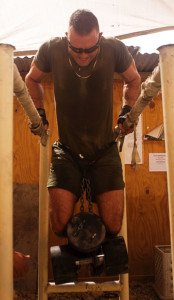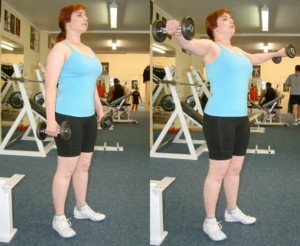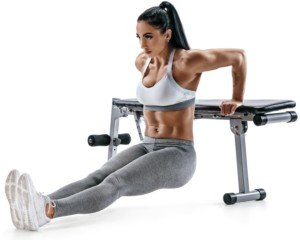
Chest pain from bar or bench dipping can be quite intense, or mild, or anything in between.
Though chest pain, in general, can be frightening, since it calls to mind the idea of having a heart attack, chest pain that occurs during dipping, or right after you complete a set of this exercise, is very much most likely caused by strain on soft tissue, rather than strain on your heart.
In fact, though a set of dips on a bar or bench can be made to be very grueling, it actually doesn’t place all that much stress on the heart.
I find that after performing highly intense sets of dips with significant weight loads, my heart rate is only minimally elevated at the conclusion.
To help avoid chest pain from bench or bar dips, here are guidelines.
Warm up properly.
I don’t treat dips as a warm-up any more than I treat bench press or deadlifts as a warm-up.
To me, this multi-joint triceps routine is as real a compound weight routine as are bench press and chin-ups.
My warm-up here is a shoulder routine, and even that has a warm-up.
Though dipping is primarily a triceps exercise, it taxes the shoulder joints, so before bench dips, I do a set of lateral raises.

GeorgeStepanek/creativecommons
This really warms up the shoulder joints including the rotator cuff, which gets hit during dips.
Any shoulder routine will do for a nice warm-up, or, if you prefer, warm up with a chest exercise.
This may be better for people who get chest pain from dips. A cold, stiff chest is more likely to be strained during dipping, than is a chest that’s warmed up with prior pressing motions.
And of course, do bodyweight-only dips before you do your heavier sets of this exercise.
If your heaviest bar dips are bodyweight-only, then do a few sets with your feet assisting; or, do seated (bench) dips as the warm-up.

Freepik.com
Some chest stretching motions will also be a good idea, and these can be done in between dip sets.
Control the negative.
Don’t drop down or let gravity assist you when lowering yourself. Control the negative as you would with the negative in a bench press or squat.
Don’t go too deep.

Freepik.com, prostooleh
I always tell my clients not to let their elbows bend more than 90 degrees. Or, to put it another way, don’t let the upper arm go past parallel with the floor.
For very trained individuals, a little past parallel is fine, but don’t overdo it.
Breathe correctly.
Inhale when you lower, and exhale when you push up.
Relax shoulders.
Don’t tense them up. Some people may do this out of nervousness when getting ready to do bar dips, or heavy-weighted bench (seated) dips.
Don’t place hands too far apart.
The further your hands are apart, the more chest muscle fiber is recruited; the more strain on the chest muscle.

Shutterstock/RomarioIen
Placing hands closer together than usual will more target the triceps and will help prevent chest pain during dips.
Don’t get ahead of yourself with increasing weight load with this multi-joint exercise. Yes, it’s so tempting to do this.
But don’t increase the weight load until you can do 12 reps. And then increase it just a little bit.
If none of these tactics work in preventing chest pain from dips, then take a break from this exercise for a few weeks or so, and focus on substitution exercises like very narrow-grip bench press and supine elbow extension with a barbell.
You may have an inflammatory process caused by injured cartilage. If rest still doesn’t combat the problem, see a sports medicine doctor.
If you experience chest pain from exercise in general, see a cardiologist immediately.


























